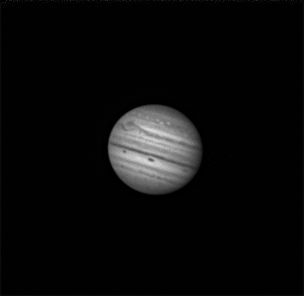Jupiter is primarily composed of hydrogen with a quarter of its mass being helium; it may also have a rocky core of heavier elements. Because of its rapid rotation, Jupiter's shape is that of an oblate spheroid. The outer
atmosphere is visibly segregated into several bands at different latitudes, resulting in turbulence and storms along their interacting boundaries. A prominent result is the Great Red Spot, a giant storm.
Surrounding the planet is a faint planetary ring system and a powerful magnetosphere. There are also at least 64 moons, including the four large moons called the Galilean moons that were first discovered by Galileo Galilei in 1610.
The Great Red Spot is a persistent high-pressure region in the atmosphere of Jupiter, producing an anticyclonic storm that is the largest in the Solar System. It produces wind-speeds up to 268 mph.

Júpiter es el quinto planeta desde el Sol y el más grande dentro del Sistema Solar. Júpiter está clasificado como un gigante gaseoso junto con Saturno, Urano y Neptuno.
Júpiter está compuesto principalmente de hidrógeno con un cuarto de su masa de helio; es posible que tenga un núcleo rocoso compuesto de elementos más pesados. Júpiter presenta una forma esférica achatada a causa de su rápida rotación. Se aprecia su atmósfera exterior dividida en varias bandas a diferentes latitudes, con turbulencias y tormentas interactuando en sus bordes. Un elemento destacado es la Gran Mancha Roja, una tormenta gigante. Rodeando el planeta se encuentra un tenue anillo planetario y un fuerte campo magnético. Hay además al menos 64 satélites, incluyendo las cuatro lunas más grandes llamadas Galileanas gracias a su descubridor, Galileo Galilei, en 1610.
La Gran Mancha Roja es el mayor vórtice anticiclónico (altas presiones) de Júpiter y el detalle de su atmósfera más conocido a nivel popular. Comparable a una enorme tormenta, se trata de un enorme remolino de poca profundidad caracterizado por vientos en su periferia de hasta 400 km/h. Su tamańo es lo bastante grande (en dirección este-oeste) como para englobar más de dos veces el diámetro de la Tierra. El remolino gira en sentido antihorario.
Esta animación compuesta de 20 imágenes de 40 segundos de exposición cada una separadas 120 segundos entre ellas (53 minutos en total), muestra la elevada velocidad de rotación de Júpiter (9h 55 minutos por rotación) y el movimiento de la Gran Mancha Roja por su superficie.


